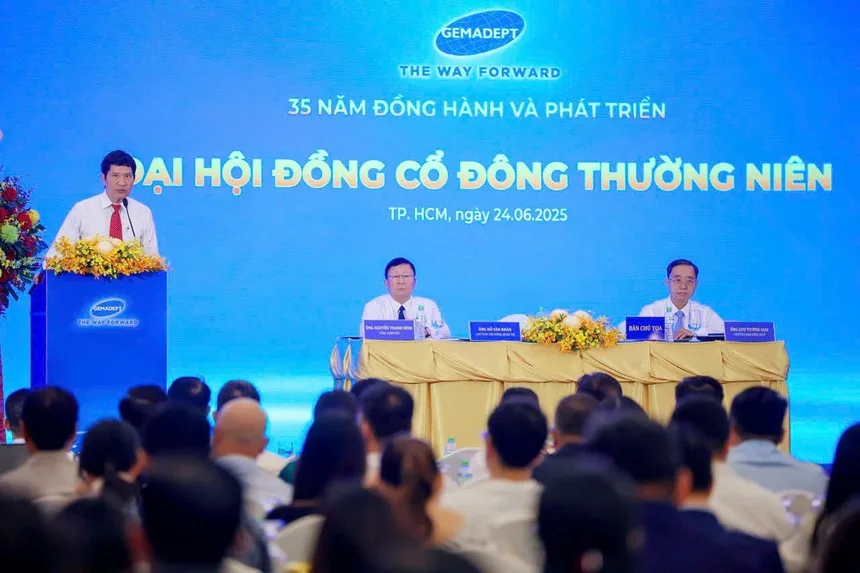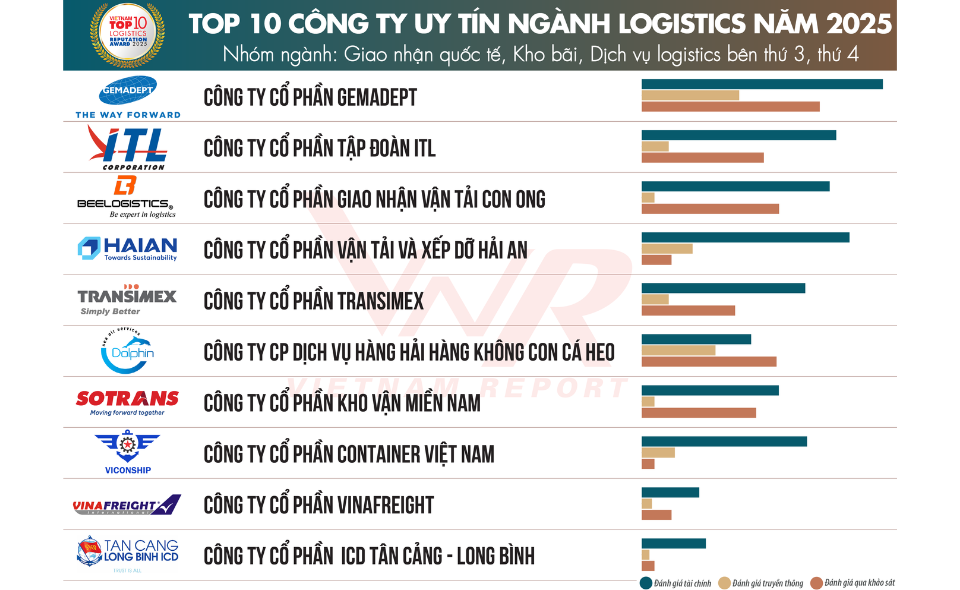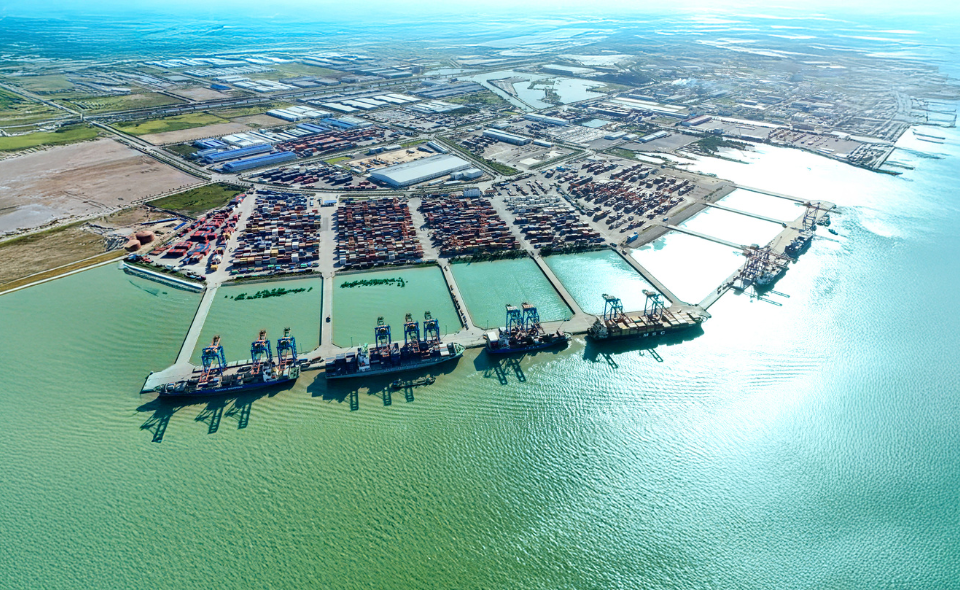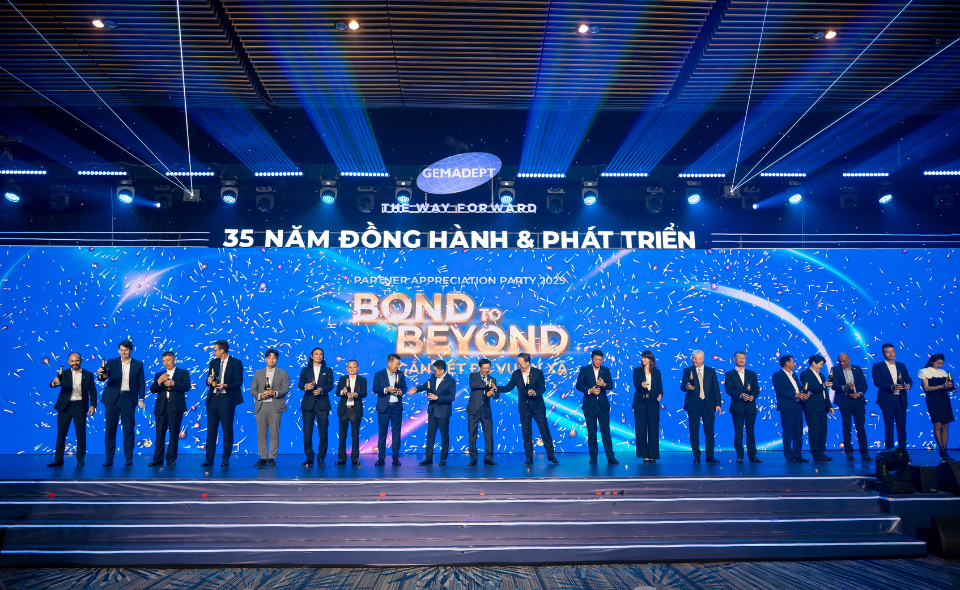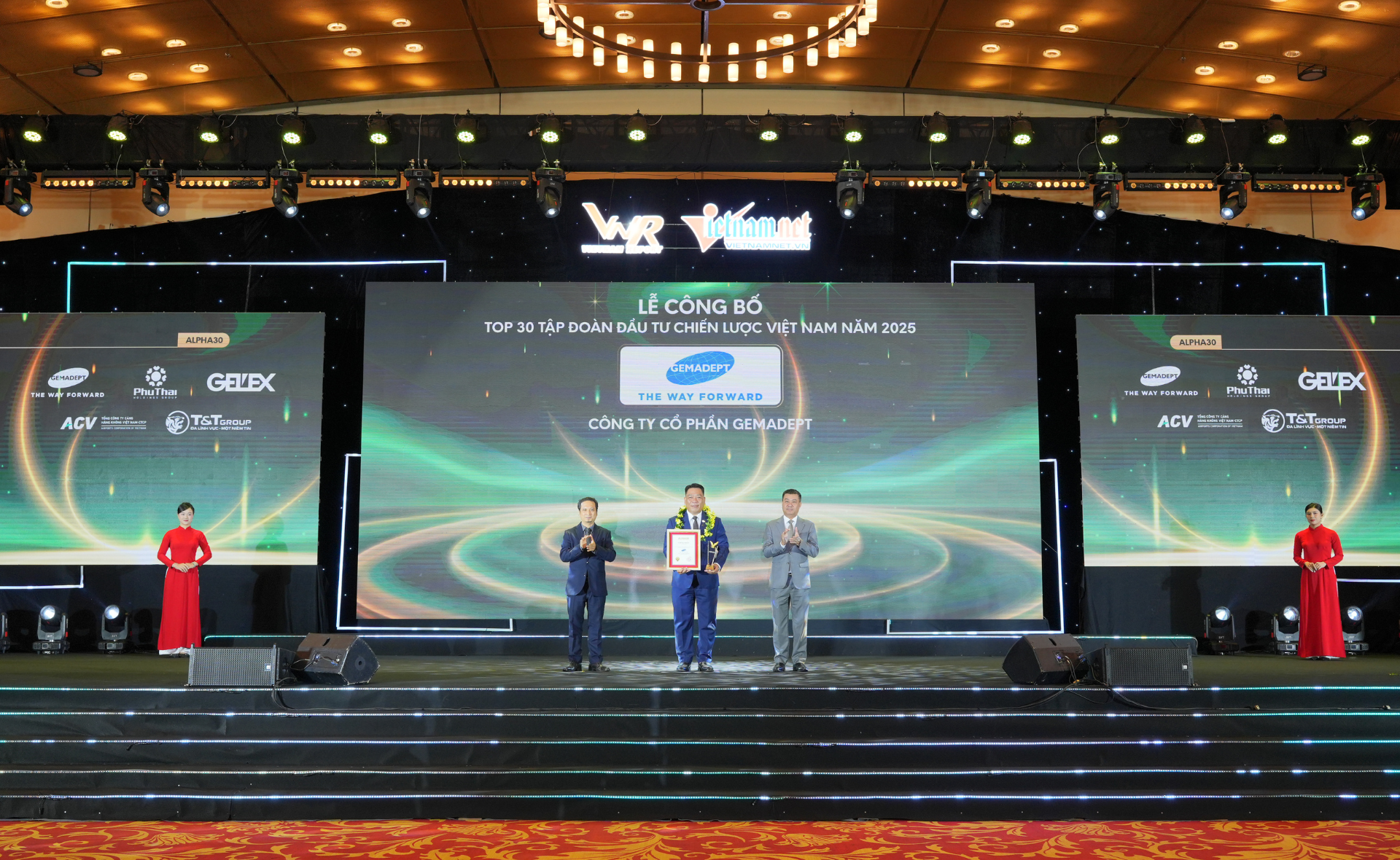(DTCK) On the morning of June 24, Gemadept Corporation (HOSE: GMD) held its 2025 Annual General Meeting of Shareholders to approve the business plan, share the investment plan, and update the progress of key projects.
Positive Business Results in the first half of 2025
Opening the General Meeting, Mr. Do Van Nhan, Chairman of Gemadept’s Board of Management, shared the achievements of 2024. He noted that in early April 2025, when US President Donald Trump announced retaliatory tariffs, global and Vietnamese stock markets wavered, and GMD shares were also impacted. However, Gemadept’s estimated business results for the first six months of 2025 are positive and align with the planned targets.
Nevertheless, with the US tariff policy after July 9 being unpredictable, the Company must be cautious with its business targets in this uncertain environment.
“As long as the market develops normally, and as long as there is no crisis, with the infrastructure upgrade project, the Nam Dinh Vu – Phase 3 project being completed at the end of this year, helping to increase capacity by 50%, along with the Gemalink 2A project and other projects, it will ensure double-digit growth for Gemadept. In addition, considering the operational capacity, operating experience, available infrastructure, and strategic location of the port cluster it owns in all three regions of the country and a strong financial foundation, the Company is capable of maintaining long-term and sustainable growth in the future,” Mr. Nhan emphasized
Specifically, in 2025 and the coming years, Gemadept will maximize operational capacity and enhance the efficiency of its integrated Port – Logistics ecosystem. The Company will also invest in partnerships, expand its concentric service chains, standardize corporate governance and risk management quality, and accelerate digital transformation. All these efforts are aimed at becoming a leading efficient enterprise in Vietnam’s maritime industry.

Panorama view of Nam Dinh Vu Port
At the same time, Gemadept continues to focus on developing important port construction investment projects, specifically: the Nam Dinh Vu Port Project – Phase 3, with an area of 23 hectares, investment capital of VND 2,800 billion, and a capacity of 650,000 TEU/year, which began in the third quarter of 2024 and is expected to be completed in the fourth quarter of 2025 (currently 80% implemented), increasing the port cluster’s total capacity to 2 million TEU/year; and the Gemalink Deep-Water Port Project – Phase 2A, with an area of 11 hectares and a capacity of 950,000 TEU/year, expected to commence in the fourth quarter of 2025 and begin operations in early 2027. Gemadept will also continue to research new projects, promote cooperation and M&A activities to maximize the efficiency of core business activities, and is determined to complete the divestment of the afforestation project in Cambodia in 2025.
Regarding financial targets, in 2025, Gemadept plans to operate under two scenarios: the registered scenario and the ambitious scenario. Under the registered scenario, revenue is expected to reach VND 4,850 billion, an increase of 21.3% compared to the 2024 plan; operating profit-before-tax is expected to be VND 1,800 billion, an increase of 33%. The ambitious scenario projects revenue of VND 4,950 billion, an increase of 23.8%, and operating profit-before-tax of VND 2,000 billion, an increase of 48% compared to the 2024 plan.
Mr. Nguyen Thanh Binh, CEO, further stated that in 2024, the company successfully upgraded and began operating the Ha Nam Canal project, deepening it from -7m to -8.5m. It also commenced and expedited construction of Phase 3 of the Nam Dinh Vu port project and launched new initiatives.
In Q1 and Q2 2025, the Company attracted new shipping routes to Europe, Asia, Africa, and Canada, diversifying its markets. It completed a capital increase through a share offering to existing shareholders and, notably, implemented technology, digital transformation, green transition, and sustainable development projects.
Repurchase up to 21 million shares and pay 20% dividend in 2024
At the General Meeting, Gemadept approved a plan for the repurchase of up to 21 million treasury shares, representing 5% of the total outstanding shares. The Board of Management will execute this share repurchase plan upon two conditions being met: first, when the Company’s share trading price drops to less than 1.5 times its book value per share; and second, after the State Securities Commission has formally acknowledged receipt of all complete documentation concerning the Company’s share repurchase. Information regarding the share repurchase will be disclosed by the Company in compliance with relevant laws.
The purpose of the share repurchase is to safeguard the company’s value and shareholders’ rights when GMD’s market price is significantly lower than the company’s fair value.
Regarding dividend policy, Gemadept approved the plan to pay a 2024 cash dividend at a rate of 20%, meaning shareholders will receive VND 2,000 per share. The Company will authorize the Board of Managementto implement the details of the 2024 cash dividend payment.
In terms of personnel, Gemadept elected Mr. Ida Shuntaro to the Board of Management, replacing Mr. Shinya Hosoi, who had submitted his resignation prior to the General Meeting. Mr. Ida Shuntaro was nominated by the SSJ Consulting (Vietnam) LLC shareholder group, which owns and represents over 42.93 million GMD shares, equivalent to 10.22% of the charter capital.
Mr. Ida Shuntaro, born in Japan in 1974, served as Head of Port Business Development at Sumitomo Corporation from 2020 to 2025. Since 2025, he has held the position of General Director at SSJ Consulting (Vietnam) LLC.
Discussion session:
The congestion on National Highway 51 gives the Company’s ICDs an advantage. So, when infrastructure projects simultaneously become operational, will this impact operation activities at the ICDs?
Mr. Nguyen The Dung, Deputy CEO, shared that the ICDs are always strategically located near industrial zones and customer factories. Combined with Gemadept’s comprehensive ecosystem, waterway transport consistently offers efficiency and volume advantages over road transport.
Regarding the ecosystem, in addition to Gemalink Deep-sea Port Cluster, the Company also owns the Phuoc Long ICD, Binh Duong Port, and others. This has significantly reduced costs and time for customers. He emphasized that even with clear roads, waterway transport will still retain its advantage.
Specifically, waterway transport remains advantageous due to the trend of significantly larger barge sizes compared to the past. Additionally, GMD has successfully implemented and applied information technology, particularly the BOS (Barge Operation System) software, which has helped transform operations, reduce waiting times, and enhance the connectivity of information flow within the Gemadept ecosystem.
Why adjust Container Handling Fees at deep-sea ports?
Mr. Pham Quoc Long, Deputy CEO, explained that while the floor price for seaport handling was adjusted up by 10% in February 2024, current container handling fees are still only 60% of regional rates, despite equivalent service quality. He added that deep-sea ports will be required to implement green and digitalization initiatives to meet global supply chain demands. Therefore, associations and businesses have petitioned the Ministry of Construction and the Vietnam Maritime Administration to adjust these fees. This adjustment is crucial for ports to secure the significant capital investment needed for green and digital transformations, ultimately enabling them to better serve customers.
When will the construction of Gemalink Phase 2A start?
Mr. Do Cong Khanh, Deputy CEO, stated that Gemalink Phase 2A is expected to begin construction in the fourth quarter of 2025 and become operational in 2027. He added that the Company will invest in Phase 2B once Phase 2A reaches 85% capacity.
Will the introduction of Lach Huyen 3, 4, and the upcoming phases affect Nam Dinh Vu Port Cluster?
Lach Huyen terminal 3 and 4, with a capacity of 2.5 million TEUs, primarily focus on large vessel sizes and routes to the US. In contrast, the Nam Dinh Vu Port Cluster holds distinct advantages, particularly for domestic routes due to significantly lower costs. Additionally, intra-Asian routes, such as those to Korea, Japan, China, and India, have shown consistent growth in recent years and are forecast to continue this trend. Therefore, the Nam Dinh Vu Port Cluster retains its competitive edge.
Does the company have access to green capital?
Ms. Bui Thi Thu Huong, CFO, shared that one of the Company’s sustainable development objectives is green development, meaning its projects are geared towards green investments. Last year, the Company signed a Sustainability Linked Loan Agreement with HSBC and a strategic financial partnership with BIDV, which includes green credit products. They also engaged with Vietcombank to invest in green equipment and vessels. Consequently, the cost of green credit will optimize expenses for the Group.
What’s the plan for divesting the rubber project?
Mr. Nguyen Thanh Binh, CEO, explained that the Company has been planning the divestment of its high-value rubber project for many years and hopes to complete it in 2025. He noted that specific information cannot be disclosed at this time as negotiations with partners are still ongoing. The purpose of this divestment is to secure capital for the continued development of potential investment projects within Gemadept’s core business segments.
What are the plans for finding a partner for the Gemalink project in the near future?
Mr. Nguyen Thanh Binh shared that the intention to partially divest from Gemalink is a method to expand cooperation with major partners, ensuring cargo flow for Gemalink Phase 2. This strategy aims to bring in a partner who will support and collaborate, leveraging synergies with Gemadept’s Port and Logistics Ecosystem and broadening the scope for future development. Therefore, the Company is currently working with potential partners to jointly develop other projects in the future.

